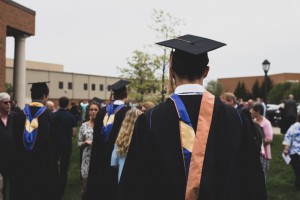Resist the Urge: Don’t cut higher education when the economy slows
September 2, 2019Resist the Urge: Don’t cut higher education when the economy slows
August 28, 2019
Murmurs of the next recession have been around for years. The Grand Canyon Institute has expressed its concerns as well. We applauded the governor for stuffing extra cash into the state’s rainy-day piggy bank at the beginning of the year by featuring a far-too-large image of an umbrella in our session-wrap blog.
News coming out the past few weeks transformed recession talk from a buzz to a bellow. Fiscally conservative Germany is now one negative quarter away from a recession, and Chinese factory output is at its lowest in the past 17 years. The stock market reacted to this news as it expectedly would: poorly. President Trump even felt the heat, postponing tariffs on some Chinese goods and proposing a cut to payroll taxes to stimulate growth (it’s not like millennials were planning on getting Social Security checks anyway).
So, let’s say the worst actually does come to pass in the United States, what can we expect to happen? Job losses, 401K collateral damage, anda preference for Netflix over standard nightlife activities are a given. But we Americans are an optimistic people, how can we find a silver-lining to an event synonymous with red ticker symbols?
Look nowhere else than an industry which gets hit hard during these times by our legislature’s austerity angst: higher education. During a recession, there are fewer jobs available. People, being the rational consumers that they are, decide that the downtime presents the perfect opportunity to further their education so that they are more competitive in the post-downturn labor market
Nationwide, the last recession caused a 33% increase in enrollment in two-year colleges from 2006 to 2011. Arizona was no exception, with the Maricopa County Community College District (MCCCD) sporting an enrollment of 215,000 students. Last academic year, MCCCD’s enrollment was 167,000. This decrease follows the decline in two-year enrollments since the recession
Arizona universities also experienced an enrollment bump during the Great Recession. Enrollment at these schools increased annually by around 2,000-3,000 between the years 2002-2007, but this number shot up to 5,000-6,000 annually during the recession. Remarkably, Arizona universities have been able to keep enrollment growth fairly consistent since the recession. This may not last forever, thanks to declining birthrates during the financial crisis. This lack of births led Nathan Graw, an economics professor at the Carleton College of Minnesota, to estimate that the number of 18 to 21 year olds will decline by 15%.
A recession, for all the woes it causes, would likely help boost enrollment numbers for both two and four-year colleges. However, given that Arizona’s current per-pupil funding to universities is currently 45% of the inflation-adjusted equivalent from 2007 (before the last recession), there is not much reason to be hopeful that a recession would solve the constraints facing higher education. Skyrocketing tuition rates since the last recession have hit student borrowers hard. Per capita student loan debt increased by 137% since the financial crisis, from $1,930 in 2007 to $4,690 in 2016.
When lawmakers go line-by-line during the next slowdown looking for fat to trim, they should think seriously about skipping over higher education. Tightening the belt on higher ed during a recession takes money away right as enrollment starts to boom. Instead, protecting this funding ensures that our workforce is that much more prepared to bounce back from the economic losses experienced during the downturn.
Photo by Charles DeLoye on Unsplash
